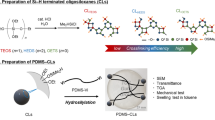Abstract
This study reanalyzes some elastomeric properties in elongation reported for poly(dimethylsiloxane) (PDMS) networks of high cross-link functionality which had been prepared by using multifunctional siloxane oligomers to end link vinyl-terminated PDMS chains. The extent of reaction of the vinyl end groupsP vi spanned the range of 0.40 to 0.95. These networks had elongation moduli that significantly exceeded the values predicted by the Flory-Erman theory, except at very low values ofP vi. Trends in their stress-strain isotherms, as characterized by the Mooney-Rivlin constants 2C 2 and the ratio 2C 2/C1, also appeared to be different from those predicted by theory. Neglected in such standard analyses, however, was the fact that the segments between cross-links along the junction precursor molecules can themselves act as short network chains, contributing to the modulus and giving a strongly bimodal distribution of both network chain lengths and cross-link functionalities. Of particular interest is the apparent change in functionality with extent of reaction and chain length distribution. The results thus obtained do suggest strong dependence of the observed values of the phantom modulus on the network chain-length distribution, particularly at very small values of the ratio of the length of the short chains to the long ones. Calculations based on recognition of these complications can be used to characterize more realistically the deformation of such networks. The results give much better agreement with experiment. Such behavior could be an important characteristic of elastomeric networks in general.
Also, a preliminary attempt was made to bridge theory with experiment based on Kloczkowski, Mark, and Erman's recent theory of fluctuations of junctions in regular bimodal networks. The agreement between theory and experiment thus obtained is rather satisfactory and lends further support to assumptions that take into account the possibly bimodal nature of these high-functionality networks.
Similar content being viewed by others
References
Lorente MA, Mark JE (1980) Macromolecules 13:681
Meyers KO, Bye ML, Merrill EW (1980) Macromolecules 13:1045
Gottlieb M, Macoscko CW, Benjamin GS, Meyers KO, Merrill EW (1981) Macromolecules 14:1039, and references cited therein
Meyers KO PhD (1980) Thesis in Chemical Engineering. Massachusetts Institute of Technology
Meyers KO, Merrill EW In: Mark JE, Lal J (eds) Elastomers and Rubber Elasticity, Am Chem Soc, Washington, DC, 1982
Kirk KA, Bidstrup SA, Merrill EW, Meyers KO (1982) Macromolecules 15:1123
Opperman W, Rehage G, In: JE Mark and J Lal (eds) Elastomers and Rubber Elasticity, (Am Chem Soc, Washington, DC, 1982)
Flory PJ (1977) J Chem Phys 66:5726
Flory PJ, Erman B (1982) Macromolecules 15:800
Mark JE, Erman B Rubber Elasticity. A Molecular Primer, Wiley Interscience, New York, 1988
Flory PJ, Erman B (1984) J Polym Sci. Polym Phys Ed 22:49
Sharaf MA, Mark JE (1991) Polym Preprints Am Chem Soc 32 (1):57
Sharaf MA, Mark JE (1990) Polym Mat Sci Eng Preprints 62:644; ms. submitted to J Polym Sci Polym Phys Ed
Sharaf MA, Mark JE (1991) J Macromol Sci, Macromol Rep A 29:67
Sharaf MA (1993) J Macromol Sci, Macromol Reports A 30:83
Llorente MA, Andrady AL, Mark JE (1981) J Polym Sci, Polym Phys Ed 19:623
Mark JE, Tang M-Y (1984) J Polym Sci, Polym Phys Ed 22:1849
Graessley WW (1975) Macromolecules 8:186
Pearson DS, Graessley WW (1978) Macromolecules 11:528
Pearson DS, Graessley WW (1980) Macromolecules 13:1001
Dossin LM, Graessley WW (1979) Macromolecules 12:123
Quesel JP, Mark JE (1985) Adv Polym Sci 71:229
Kloczkowski A, Mark JE, Erman B (1991) Macromolecules 24:3266
Higgs PG, Ball RC (1989) J Phys (Fr). 49:1785
Mooney M (1940) J Appl Phys 11:582
Rivilin RS (1948) Philos Trans Roy Soc London, Ser A 241:379
Erman B, Flory PJ (1982) Macromolecules 15:806
Sharaf MA (1992) Int J Polym Mat 18,237
Sharaf MA, Mark JE, AL Hosani ZY, in press, Eur Polym J
Author information
Authors and Affiliations
Rights and permissions
About this article
Cite this article
Sharaf, M.A., Mark, J.E. & Ahmed, E. Elastomeric properties of end-linked networks of high cross-link functionality. Accounting for possible changes in effective functionality with extent of reaction and chain-length distribution. Colloid Polym Sci 272, 504–515 (1994). https://doi.org/10.1007/BF00653214
Received:
Accepted:
Issue Date:
DOI: https://doi.org/10.1007/BF00653214



